
Gotthardbahn
Encyclopedia
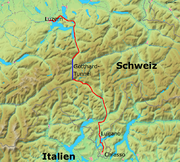
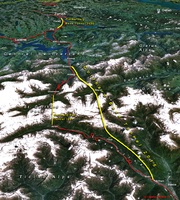

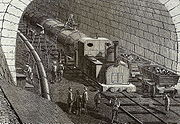



Switzerland
Switzerland name of one of the Swiss cantons. ; ; ; or ), in its full name the Swiss Confederation , is a federal republic consisting of 26 cantons, with Bern as the seat of the federal authorities. The country is situated in Western Europe,Or Central Europe depending on the definition....
railway company which operated the railway line from Immensee (canton of Schwyz
Canton of Schwyz
Schwyz is a canton in central Switzerland between the Alps in the south, Lake Lucerne in the east and Lake Zurich in the north, centered around and named after the town of Schwyz....
) to Chiasso
Chiasso
Chiasso is a municipality in the district of Mendrisio in the canton of Ticino in Switzerland.As the southernmost of Switzerland's municipalities, Chiasso is located at the border with Italy, in front of Ponte Chiasso...
(Italian border). Nowadays this term usually does not refer to that company, but to the railway line itself. The line will be integrated with the Gotthard Base Tunnel
Gotthard Base Tunnel
The Gotthard Base Tunnel is a new railway tunnel beneath the Swiss Alps, expected to open in 2016. With a route length of and a total of of tunnels, shafts and passages, it is the world's longest rail tunnel, surpassing the Japanese Seikan Tunnel....
when it opens.
Construction
After the Semmering railwaySemmering Railway
The Semmering railway, Austria, which starts at Gloggnitz and leads over the Semmering to Mürzzuschlag was the first mountain railway in Europe built with a standard gauge track. It is commonly referred to as the world's first true mountain railway, given the very difficult terrain and the...
, the Brenner railway
Brenner railway
The Brenner Railway is a major line connecting the Austrian and Italian railways from Innsbruck and Verona climbing the Wipptal , passing over the Brenner Pass and descending down the Eisack Valley to Bolzano and then down the Adige Valley from Bolzano to Rovereto and from there along the...
and the Mont-Cenis-Route the Gotthardbahn was the fourth railway line through the Alps
Alps
The Alps is one of the great mountain range systems of Europe, stretching from Austria and Slovenia in the east through Italy, Switzerland, Liechtenstein and Germany to France in the west....
. Construction started 1872 after long discussions about the best layout of the line and treaties with the Kingdom of Italy
Italy
Italy , officially the Italian Republic languages]] under the European Charter for Regional or Minority Languages. In each of these, Italy's official name is as follows:;;;;;;;;), is a unitary parliamentary republic in South-Central Europe. To the north it borders France, Switzerland, Austria and...
(1869) and the German Empire
German Empire
The German Empire refers to Germany during the "Second Reich" period from the unification of Germany and proclamation of Wilhelm I as German Emperor on 18 January 1871, to 1918, when it became a federal republic after defeat in World War I and the abdication of the Emperor, Wilhelm II.The German...
(1871). The first lowland sections Biasca
Biasca
Biasca is a town of the district of Riviera in the canton of Ticino in Switzerland.-History:Biasca is first mentioned in 830 as Aviasca in the Liber viventium of Pfäfers Abbey. In 1119 it was mentioned as Abiasca.-Early history:...
-Giubiasco
Giubiasco
Giubiasco is a municipality in the district of Bellinzona in the canton of Ticino in Switzerland.-History:Due to its location at the center of numerous routes through the Alps, Giubiasco has been important since ancient times...
-Locarno
Locarno
Locarno is the capital of the Locarno district, located on the northern tip of Lake Maggiore in the Swiss canton of Ticino, close to Ascona at the foot of the Alps. It has a population of about 15,000...
and Lugano
Lugano
Lugano is a city of inhabitants in the city proper and a total of over 145,000 people in the agglomeration/city region, in the south of Switzerland, in the Italian-speaking canton of Ticino, which borders Italy...
-Chiasso
Chiasso
Chiasso is a municipality in the district of Mendrisio in the canton of Ticino in Switzerland.As the southernmost of Switzerland's municipalities, Chiasso is located at the border with Italy, in front of Ponte Chiasso...
were opened by 1874.
Original Bridge Constructions
The Gotthardbahn and its branchlines pass over a total of 1234 bridgeBridge
A bridge is a structure built to span physical obstacles such as a body of water, valley, or road, for the purpose of providing passage over the obstacle...
s and open passages which span a total of 6471 [m]. Arch bridge
Arch bridge
An arch bridge is a bridge with abutments at each end shaped as a curved arch. Arch bridges work by transferring the weight of the bridge and its loads partially into a horizontal thrust restrained by the abutments at either side...
s from stone were only constructed up to a clear width of 12 [m], bridging larger distances with iron superstructure
Superstructure
A superstructure is an upward extension of an existing structure above a baseline. This term is applied to various kinds of physical structures such as buildings, bridges, or ships...
s, which therefore became a frequent sight on the original Gotthard line, their iron representing a weight of 17723 tons. The construction of each bridge represented its own individual challenge, depending on the surrounding geography
Geography
Geography is the science that studies the lands, features, inhabitants, and phenomena of Earth. A literal translation would be "to describe or write about the Earth". The first person to use the word "geography" was Eratosthenes...
and geology
Geology
Geology is the science comprising the study of solid Earth, the rocks of which it is composed, and the processes by which it evolves. Geology gives insight into the history of the Earth, as it provides the primary evidence for plate tectonics, the evolutionary history of life, and past climates...
.
With the exception of three arch bridges all steel bridges consisted of very simple, straight, single beam truss construction
Truss bridge
A truss bridge is a bridge composed of connected elements which may be stressed from tension, compression, or sometimes both in response to dynamic loads. Truss bridges are one of the oldest types of modern bridges...
s. These had to be reinforced already before 1914 still during steam operation
Steam locomotive
A steam locomotive is a railway locomotive that produces its power through a steam engine. These locomotives are fueled by burning some combustible material, usually coal, wood or oil, to produce steam in a boiler, which drives the steam engine...
of the Gotthardbahn due to quickly increasing traffic and load. Fish-belly truss
Truss
In architecture and structural engineering, a truss is a structure comprising one or more triangular units constructed with straight members whose ends are connected at joints referred to as nodes. External forces and reactions to those forces are considered to act only at the nodes and result in...
structures were attached to the bridges from below where possible and an arch truss structure was added from the top, where a short clear height made this necessary, besides other measures. Eventually all original iron bridges had to be replaced with modern bridges because they had been built and were repeatedly reinforced to specifications that again and again were surpassed by increasing traffic, velocity and load.
Notable originally single beam truss bridges on the Gotthardbahn are:
The Chärstelenbach Bridge has two passage ways with clear widths of 50 [m] each and rails at 53 [m] above low water. The bridge was reinforced with a fish-belly structure. The modern replacement still uses the centre column and the stone arch abutements of the original.
The Inschi-Reuss-Bridge spans the widest clear width of 75 [m], with rails at 76 [m] above low water. The bridge was reinforced with a "fish-belly" before the iron structure was replaced.
The Middle Meienreuss Bridge spans 65 [m] with rails 72 [m] above the river bottom. The original iron construction has been replaced.
The whole line was inaugurated with festivities in Lucerne
Lucerne
Lucerne is a city in north-central Switzerland, in the German-speaking portion of that country. Lucerne is the capital of the Canton of Lucerne and the capital of the district of the same name. With a population of about 76,200 people, Lucerne is the most populous city in Central Switzerland, and...
and Chiasso from 21 May to 25 May 1882. Scheduled operation started on 1 June. At the time, the 15,003-meter-long Gotthard Rail Tunnel
Gotthard Rail Tunnel
The Gotthard Rail Tunnel, is a 15-kilometre long railway tunnel and forms the summit of the Gotthard Railway in Switzerland. It connects Göschenen with Airolo and was the first tunnel through the Gotthard massif...
was the world's longest rail tunnel (seconded by the Simplon Tunnel
Simplon Tunnel
The Simplon Tunnel is an Alpine railway tunnel that connects the Swiss town of Brig with Domodossola in Italy, though its relatively straight trajectory does not run under Simplon Pass itself. It actually consists of two single-track tunnels built nearly 20 years apart...
in 1906). Soon after construction, the line was secured by the army with fortresses (for instance above Airolo and at Biasca) and ways to block the tunnel in case of an invasion (among others an artificial landslide to block the southern tunnel entrance).
At the same time the Aargauische Südbahn completed the section Rotkreuz-Immensee, which provided a rail link from Aarau
Aarau
Aarau is the capital of the northern Swiss canton of Aargau. The city is also the capital of the district of Aarau. It is German-speaking and predominantly Protestant. Aarau is situated on the Swiss plateau, in the valley of the Aar, on the river's right bank, and at the southern foot of the Jura...
to Arth-Goldau. The feeder lines to Lucerne
Lucerne
Lucerne is a city in north-central Switzerland, in the German-speaking portion of that country. Lucerne is the capital of the Canton of Lucerne and the capital of the district of the same name. With a population of about 76,200 people, Lucerne is the most populous city in Central Switzerland, and...
and Zurich
Zürich
Zurich is the largest city in Switzerland and the capital of the canton of Zurich. It is located in central Switzerland at the northwestern tip of Lake Zurich...
were completed in 1887.
In 1909, the Gotthardbahn was integrated into the network of the Swiss Federal Railways, which had been founded in 1902. The whole line was electrified with 15 kV alternating current
Alternating current
In alternating current the movement of electric charge periodically reverses direction. In direct current , the flow of electric charge is only in one direction....
(single phase, 16⅔ Hz) in 1922.
Immensee - Erstfeld
Starting at Immensee, the line follows the Lake of ZugLake of Zug
Lake Zug is a lake in Central Switzerland, situated between Lucerne and Zurich. The Lorze as the main feeder river empties its waters into the lake at its northern extremity, but 1 km further west issues from the lake to pursue its course towards the Reuss...
to Arth-Goldau (510 meters). Here the line from Zurich joins and the Südostbahn
Südostbahn
The Südostbahn – commonly abbreviated to SOB – is a railway company and network in Switzerland.- Structure :...
route to Biberbrugg
Biberbrugg
Biberbrugg is a village in the canton of Schwyz in Switzerland. Biberbrugg is shared by the municipalities of Einsiedeln in the district of Einsiedeln and Feusisberg in the district of Höfe.- History :...
-Rapperswil
Rapperswil
Rapperswil-Jona is a municipality in the Wahlkreis of See-Gaster in the canton of St. Gallen in Switzerland.Besides Rapperswil and Jona, which were separate municipalities until 2006, the municipality includes Bollingen, Busskirch, Curtiberg, Kempraten-Lenggis, Wagen, and Wurmsbach.-Today:On...
/Einsiedeln
Einsiedeln, Switzerland
Einsiedeln is a municipality and district in the canton of Schwyz in Switzerland known for its monastery, the Benedictine Einsiedeln Abbey. Einsiedeln is also the birthplace of Paracelsus, a Renaissance physician and alchemist who is credited with first naming zinc.-Prehistoric...
branches; further, there is a connection to the Arth-Rigi-Bahn, a rack railway climbing the Rigi
Rigi
- Mt. Rigi in Art:Mt. Rigi has been featured in many works of art, including both paintings and literary publications. Perhaps the most famous paintings of the Rigi were by JMW Turner, including "The Blue Rigi, Lake of Lucerne, Sunrise"...
. Then it follows the Lauerzer See and passes Schwyz
Schwyz
The town of is the capital of the canton of Schwyz in Switzerland.The Federal Charter of 1291 or Bundesbrief, the charter that eventually led to the foundation of Switzerland, can be seen at the Bundesbriefmuseum.-History of the toponym:...
, the capital of the canton of Schwyz
Canton of Schwyz
Schwyz is a canton in central Switzerland between the Alps in the south, Lake Lucerne in the east and Lake Zurich in the north, centered around and named after the town of Schwyz....
(455 meters). From Brunnen
Brunnen
Brunnen is a resort on Lake Lucerne in Switzerland, part of the municipality Ingenbohl , at .Brunnen has a cablecar that goes to the Urmiberg, a part of the Rigi offering wonderful views of Lake Lucerne and the Alps....
to Fluelen
Flüelen
Flüelen is a municipality in the canton of Uri in Switzerland.-Geography:Flüelen has an area, , of . Of this area, 22% is used for agricultural purposes, while 55.1% is forested. Of the rest of the land, 6.1% is settled and the remainder is non-productive...
, the line follows the Vierwaldstätter See (that part of it is also referred to as Urnersee). In that section, the Axen, the two tracks follow two different routes mainly in tunnel because the second track was built later (up to 1943) and on a straighter route through longer tunnels. Erstfeld
Erstfeld
Erstfeld is a municipality in the canton of Uri in Switzerland.-History:Erstfeld is first mentioned in 1258 as Ourzcvelt. In 1638 it was listed under the Latin name in Protocampis. In 1831 it was known as Hirschfelden.-Geography:...
(472 metres) is finally reached via Altdorf
Altdorf, Switzerland
Altdorf is the capital of the Swiss canton of Uri. The municipality covers an area of and is located at a height of above sea-level, to the right of the river Reuss.-Location:...
, and the northern ramp begins.
Northern ramp, Erstfeld - Göschenen


Bank engine
A bank engine or helper engine or pusher engine is a railway locomotive that temporarily assists a train that requires additional power or traction to climb a grade...
. A Ce 6/8 "crocodile"
Crocodile (locomotive)
Crocodile electric locomotives are so called because they have long "noses" at each end, reminiscent of the snout of a crocodile . These contain the motors and drive axles, and are connected by an articulated center section. The center section usually contains the crew compartments, pantographs...
serves as a memorial for the legendary Gotthard locomotives.
The track now gets steeper with a gradient
Gradient
In vector calculus, the gradient of a scalar field is a vector field that points in the direction of the greatest rate of increase of the scalar field, and whose magnitude is the greatest rate of change....
of up to 28‰. After Amsteg the line passes the Chärstelenbach bridge and changes the side of the Reuss
Reuss River
The Reuss is a river in Switzerland. With a length of and a drainage basin of , it is the fourth largest river in Switzerland...
valley over the Intschireuss bridge, which is, with its 77 metres, the highest bridge in the SBB network. After Gurtnellen
Gurtnellen
Gurtnellen is a municipality in the canton of Uri in Switzerland.-History:Gurtnellen is first mentioned in 1257 as Chuno und die Gurteneller. In 1321 it was mentioned as Gruntellon, and in 1359 as Gurtenellen.-Geography:...
(738 meters), the first spirals
Spiral (railway)
A spiral is a technique employed by railways to ascend steep hills.A railway spiral rises on a steady curve until it has completed a loop, passing over itself as it gains height, allowing the railway to gain vertical elevation in a relatively short horizontal distance...
follow; their purpose is mainly to gain height where no space is available. Two of them form the double loop of Wassen
Wassen
Wassen is a municipality in the canton of Uri in Switzerland.-Geography:Wassen has an area, , of . Of this area, 12.5% is used for agricultural purposes, while 18.2% is forested. Of the rest of the land, 1.1% is settled and the remainder is non-productive...
(928 metres), which allows the famous church of Wassen to be seen three times from different perspectives, first from below and the last time 200 meters above. The line passes over the river Reuss three times in this section.
After yet another 1570-metre-long tunnel, the line reaches Göschenen
Göschenen railway station
Göschenen railway station, in the Canton of Uri, Switzerland, is an important railway junction on the Gotthardbahn railway line, at the northern end of the Gotthard Rail Tunnel....
(1106 meters), where passengers can take a metre gauge
Metre gauge
Metre gauge refers to narrow gauge railways and tramways with a track gauge of . In some African, American and Asian countries it is the main gauge. In Europe it has been used for local railways in France, Germany, and Belgium, most of which were closed down in mid 20th century. Only in Switzerland...
rack railway
Rack railway
A rack-and-pinion railway is a railway with a toothed rack rail, usually between the running rails. The trains are fitted with one or more cog wheels or pinions that mesh with this rack rail...
train operated by the Matterhorn Gotthard Bahn on the former Schöllenenbahn, Furka Oberalp Bahn, to Andermatt
Andermatt railway station
Andermatt railway station is an important railway junction on the metre gauge Furka Oberalp Bahn . It serves the municipality of Andermatt, in the Canton of Uri, Switzerland...
and from there over the Oberalppass to Chur
Chur railway station
Chur railway station serves the city of Chur, capital of the Canton of Graubünden, Switzerland. Opened in 1858, it is the most important railway junction in Graubünden....
or through the Furka Tunnel
Furka Tunnel
The Furka Base Tunnel is a 15.4 km long Swiss rail tunnel that connects Oberwald in the Canton of Valais with Realp in the Canton of Uri. The base tunnel replaced the previous overland track that climbed to an apex of 2160 metres above sea level at the Furka stop below Furka Pass...
to Brig
Brig, Switzerland
Brig, officially Brig-Glis is a municipality in the district of Brig in the canton of Valais in Switzerland.The current municipality was formed in 1972 through the merger of Brig , Brigerbad and Glis.-History:...
.
Gotthard Tunnel
The Gotthard Rail TunnelGotthard Rail Tunnel
The Gotthard Rail Tunnel, is a 15-kilometre long railway tunnel and forms the summit of the Gotthard Railway in Switzerland. It connects Göschenen with Airolo and was the first tunnel through the Gotthard massif...
is a 15,003-metre-long, double-track tunnel, built as one tube. The highest point of the Gotthard line is within this tunnel, 1151 metres above sea level. The tunnel crosses the border between the canton of Uri
Canton of Uri
Uri is one of the 26 cantons of Switzerland and a founding member of the Swiss Confederation. It is located in Central Switzerland. The canton's territory covers the valley of the Reuss River between Lake Lucerne and the St. Gotthard Pass. German is the primary language spoken in Uri...
and the canton Ticino.
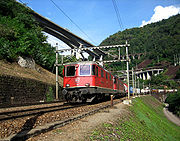
Southern ramp, Airolo - Biasca


Ticino
Canton Ticino or Ticino is the southernmost canton of Switzerland. Named after the Ticino river, it is the only canton in which Italian is the sole official language...
and descends through the valley Leventina. At Piotta, there is an 87.8% steep funicular railway to the Ritom dam. Behind Rodi-Fiesso (942 metres), the most impressive section of the southern ramp begins. The valley narrows to the Piotta canyon, and the line passes two spirals ("Piottino-Loops") to lose 200 meters' height before reaching Faido
Faido
Faido is the capital of the district of Leventina in the Italian-speaking canton of Ticino in southern Switzerland.On 29 January 2006, Faido grew by incorporating the villages of Chiggiogna, Rossura, and Calonico.-History:...
. Two more spirals, known as the "Biaschina-Loops", lead the line down to Giornico (391 metres). The valley broadens and the line arrives at Biasca
Biasca
Biasca is a town of the district of Riviera in the canton of Ticino in Switzerland.-History:Biasca is first mentioned in 830 as Aviasca in the Liber viventium of Pfäfers Abbey. In 1119 it was mentioned as Abiasca.-Early history:...
(293 meters).
Biasca - Bellinzona - Luino
From Biasca to BellinzonaBellinzona
Bellinzona is the administrative capital of the canton Ticino in Switzerland. The city is famous for its three castles that have been UNESCO World Heritage Sites since 2000....
(241 metres), the capital of the canton Ticino, the line follows the river Ticino. At Giubiasco
Giubiasco
Giubiasco is a municipality in the district of Bellinzona in the canton of Ticino in Switzerland.-History:Due to its location at the center of numerous routes through the Alps, Giubiasco has been important since ancient times...
, the line to Locarno
Locarno
Locarno is the capital of the Locarno district, located on the northern tip of Lake Maggiore in the Swiss canton of Ticino, close to Ascona at the foot of the Alps. It has a population of about 15,000...
and Luino
Luino
Luino is a small town and comune near the border with Switzerland on the eastern shore of Lake Maggiore, in the Province of Varese ....
branches. Originally the main line was the track to Luino
Luino
Luino is a small town and comune near the border with Switzerland on the eastern shore of Lake Maggiore, in the Province of Varese ....
, to connect the line with the Italian network and the Genoa
Genoa
Genoa |Ligurian]] Zena ; Latin and, archaically, English Genua) is a city and an important seaport in northern Italy, the capital of the Province of Genoa and of the region of Liguria....
port.
Eventually, a second line over Monte Ceneri to Lugano
Lugano
Lugano is a city of inhabitants in the city proper and a total of over 145,000 people in the agglomeration/city region, in the south of Switzerland, in the Italian-speaking canton of Ticino, which borders Italy...
, Como
Como
Como is a city and comune in Lombardy, Italy.It is the administrative capital of the Province of Como....
and Milan
Milan
Milan is the second-largest city in Italy and the capital city of the region of Lombardy and of the province of Milan. The city proper has a population of about 1.3 million, while its urban area, roughly coinciding with its administrative province and the bordering Province of Monza and Brianza ,...
was also build for smaller and passenger only trains. For this reason the gradient on the Ceneri line is higher than the gradient of the Alp tracks.
Bellinzona - Chiasso
At GiubiascoGiubiasco
Giubiasco is a municipality in the district of Bellinzona in the canton of Ticino in Switzerland.-History:Due to its location at the center of numerous routes through the Alps, Giubiasco has been important since ancient times...
, the line rises again to the Monte Ceneri and then passes through two parallel, single-track tunnels. It reaches the highest point on this part of the line, Rivera-Bironico, at 472 metres. Then it descends to Lugano
Lugano
Lugano is a city of inhabitants in the city proper and a total of over 145,000 people in the agglomeration/city region, in the south of Switzerland, in the Italian-speaking canton of Ticino, which borders Italy...
at 335 metres.
Following the western waterside of the Lago di Lugano, the line arrives at Melide
Melide, Switzerland
Melide is a municipality in the district of Lugano in the canton of Ticino in Switzerland. The village lies very close to the mountain Monte San Salvatore and is directly on the Lake of Lugano...
, where the Swissminiatur can be found, which shows Switzerland's best known tourist features at a 1:25 scale. The Lago di Lugano is crossed over an 817-meter-long bridge and dam and the track follows the eastern waterside to Capolago
Capolago
Capolago was a municipality in the district of Mendrisio in the canton of Ticino in Switzerland, but is now part of the municipality of Mendrisio. On 25 November 2007 the municipalities of Arzo, Capolago, Genestrerio, Mendrisio, Rancate and Tremona voted to merge into the municipality of Mendrisio...
and Mendrisio
Mendrisio
Mendrisio is a municipality in the district of Mendrisio in the canton of Ticino in Switzerland.Mendrisio is the seat of the Accademia di Architettura of the university of Italian speaking Switzerland ....
. After over 200 kilometers the station Chiasso
Chiasso
Chiasso is a municipality in the district of Mendrisio in the canton of Ticino in Switzerland.As the southernmost of Switzerland's municipalities, Chiasso is located at the border with Italy, in front of Ponte Chiasso...
is reached, which houses the Italian customs and has a big international shunting yard. Conventional trains change locomotives here due to different traction voltages and train protection systems in Italy.
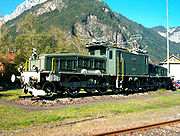
Stock
Most of the Swiss locomotives were originally constructed for the Gotthard line, so many of them were called "Gotthardlokomotiven", for instance C 5/6 "Elephant"SBB-CFF-FFS C 5/6
The C 5/6 was a steam locomotive in use with Swiss Federal Railways. 28 locomotives were built between 1913 and 1917; all had been withdrawn by 1968. Three have been preserved, one of them in working order. The class was designed for use on the steep inclines of the Gotthard route, and was...
, Ce 6/8 and Be 6/8 "Krokodil"
Crocodile (locomotive)
Crocodile electric locomotives are so called because they have long "noses" at each end, reminiscent of the snout of a crocodile . These contain the motors and drive axles, and are connected by an articulated center section. The center section usually contains the crew compartments, pantographs...
, Ae 8/14 "Landilok", Ae 6/6
SBB-CFF-FFS Ae 6/6
The Ae 6/6 is a heavy electric locomotive used by the SBB-CFF-FFS. It is sometimes also referred to as canton locomotive , because the first 25 locomotives were named after the cantons, and carried the canton's coat of arms on the side and chrome embellishments , and the Swiss coat of arms...
, Re 620
SBB-CFF-FFS Re 620
The Re 620, Re 6/6 in the old numbering scheme, are six-axle, electric locomotives of the SBB-CFF-FFS, which were acquired as a replacement for the Ae 6/6 for heavy services on the Gotthardbahn...
. Famous trainsets on the Gotthard route are the Trans Europ Express
Trans Europ Express
The Trans Europ Express, or Trans-Europe Express, is a former international railway service in Europe. At its maximum extent, in 1974, the network comprised 45 trains, connecting 130 different cities.-Origin:...
and the Rote Pfeil, as well as the tilting train Cisalpino Pendolino
Pendolino
Pendolino is an Italian family of tilting trains used in Italy, Spain, Portugal, Slovenia, Finland, Russian Federation, the Czech Republic, the United Kingdom, Slovakia, Switzerland, China and shortly in Romania and Poland...
.
Nowadays passenger trains are mostly pulled by Re 4/4 II (up to two for long trains) and sometimes by Re 460, freight trains by Re 6/6 and Re 4/4 III. Up to 1300 tons may be pulled by an Re 6/6 with an Re 4/4 III (this combination is sometimes referred to as Re 10/10); if the trains are heavier they have to be pushed by an additional Re 4/4 or Re 6/6, because the couplers are too weak to pull the entire train on the steep slopes.
Besides trains operated by the Swiss Federal Railways, other railway companies also run their trains on the Gotthard route since 2001 ("open access"). These include, for instance, Cisalpino AG (Pendolino and ordinary passenger trains) and Deutsche Bahn AG (mostly freight from Germany to Italy).
External links
- http://www.lokifahrer.ch/Strecken/gotthardbahn.htm Detailed description by Bruno Lämmli, in German
- Gotthardbahn.de German Webpage by Jan Keckstein, very nicely interlinking a very complete set of sceneries with their location on route maps and route tables. Last updated in Nov. 2005.

